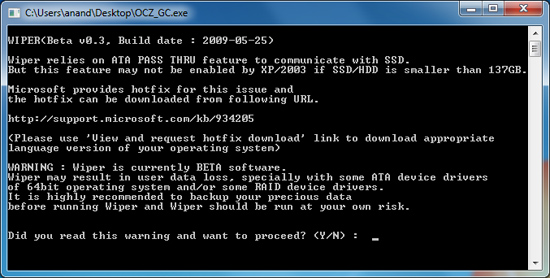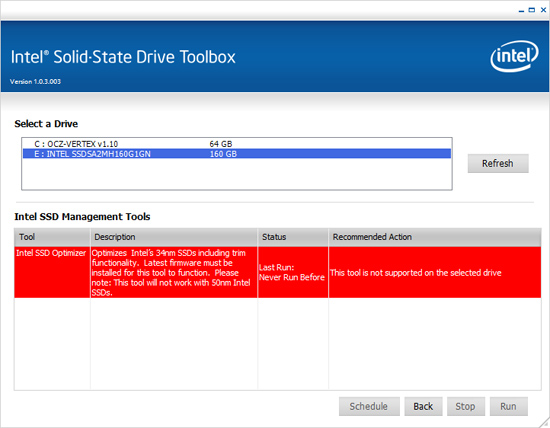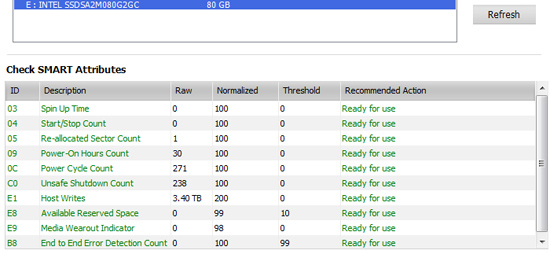The SSD Improv: Intel & Indilinx get TRIM, Kingston Brings Intel Down to $115
by Anand Lal Shimpi on November 17, 2009 7:00 PM EST- Posted in
- Storage
Wipe When You Can’t TRIM
There’s a major problem with TRIM today. The only Windows storage drivers to support it are written by Microsoft. The Intel Matrix Storage Manager (IMSM) driver will not pass the TRIM instruction to your SSD. This means you can't use anything but the drivers that ship with Windows 7. To make matters worse, if you enable non-member RAID on an Intel motherboard the default Windows 7 driver is an older version of IMSM so TRIM won't work there either - even if you don't have a RAID array created. Your best bet is to install Windows 7 with your I/O controller in AHCI mode (for Intel chipsets) and don't install any storage drivers. Intel is working on an updated IMSM that will pass the TRIM instruction to SSDs but it won't be ready for at least a couple of months.
TRIM won't work on a RAID array.
If you want to use IMSM or if you're using Windows XP or Vista, both of which do not support TRIM, there's another option. Earlier this year Indilinx released its Wiper Tool that performs a manual TRIM on their SSDs. It works by asking the OS for a list of the free space addresses on the partition and then sending the list with instructions to TRIM down to the SSD.

The Indilinx Wiper Tool
Today Intel introduces its own manual TRIM tool as a part of the SSD Toolbox:

On any Windows OS (XP, Vista or 7) regardless of what driver you have installed, Intel's SSD Toolbox will allow you to manually TRIM your drive. Intel calls it the SSD Optimizer, which of course only works on 34nm Intel SSDs (X25-M G1 owners are out of luck unfortunately).

The Intel SSD Optimizer lets you schedule the manual TRIM operation automatically
The SSD Toolbox also gives you access to SMART and drive health data, including telling you how many writes you've performed on your SSD, and what your current flash wear level is:

Running Intel's SSD Optimizer does work as advertised. I ran the PCMark HDD suite on a clean X25-M, once more on a drive that had been well used and once more after running the SSD Optimizer:
| PCMark Vantage HDD Score | Clean Run | Used Run | After SSD Optimizer |
| Intel X25-M G2 160GB | 35909 | 30354 | 34014 |
Intel's SSD Optimizer should be able to restore performance to about 95%+ of new, in this case it manages 94.7% - close enough.
Moving On: Forget About Invalid Data and Worry About Free Space
The existence of TRIM changes the way we test, something I alluded to in the SSD Relapse. Thankfully, we come prepared.
In previous articles we had to test SSDs in two conditions: new and used. The new state is just after a secure erase, the used state required us to write data to every user accessible portion of the drive first before benchmarking. The former resulted in great performance, the latter meant the SSD had to do a lot of juggling of existing data whenever it went to write. The second scenario no longer exists with TRIM. The act of formatting your drive or deleting files (and emptying the recycle bin) will TRIM invalid data.
Performance in a TRIM enabled system is now determined not by the number of invalid blocks on your SSD, but rather the amount of free space you have. I went into a deep explanation of the relationship between free space and the performance of some SSDs here.
TRIM will make sure that you don’t have to worry about your drive filling up with invalid data, but it doesn’t skirt the bigger issue: dynamic controllers see their performance improve with more free space.
My rule of thumb is to keep at least 20% free space on your drive, you can get by with less but performance tends to suffer. It doesn’t degrade by the same amount for all drives either. Some controllers are more opportunistic with free space (e.g. Intel), while others don’t seem to rely as much on free space for improved performance. Addressing performance degradation as drives fill up (with valid data) will be one of the next major advancements in SSD technology.










162 Comments
View All Comments
The0ne - Monday, October 26, 2009 - link
No kidding. Early adopters really shouldn't complain, that's what you get for being the "elite." LMAO.As I've said before, just wait til early next to summer and the tech will be more mature. Yea, go ahead and make your argument that you can wait til next year but by then they'll be new products. That's cool...but I think ppl saying this have no clue about what's really happening around the technology.
Regardless, sounds nice to be saying it so woohooo be the first!
klil - Monday, October 26, 2009 - link
I dont think that you should lose the wiper and trim support for being an early adapter, it does not make senseThe only early adapter lesson i know of was that one from a intel processor that had a bug... pentiums from 1994: http://en.wikipedia.org/wiki/Pentium_FDIV_bug">http://en.wikipedia.org/wiki/Pentium_FDIV_bug
If they were not able to put it in due to hardware problems its one thing... but those drives cost 665 dollars in the beggining. I bet that if you had one you would not be happy :|
pcfxer - Tuesday, October 27, 2009 - link
ADOPTER, A-D-O-P-T-E-R.I can't even fathom how you could read what someone posts, "early adopter this....early adopter thaaat" and you go and type ADAPTER.
Adapter -> Adaptation between two or more objects.
Did you not have coffee yet man?
chizow - Monday, October 26, 2009 - link
Agreed, Intel will certainly meet more resistance in the future for their emergent technologies and undoubtedly lost the support of many of their most dedicated supporters with this decision.If there were some technical reason or incompatibility behind the lack of TRIM support on G1 that'd be one thing, but from what has been published by AT and others, its nothing more than indifference on Intel's part preventing support.
Blur - Tuesday, October 27, 2009 - link
Eloquently stated, i bought two of the G1 drives. I won't be suckered into supporting any of intels new tech early again and I'll be taking a much closer look at their competitors products when purchasing more established tech.Zingam - Monday, October 26, 2009 - link
Is there a change that a newer better technology will replace Flash so that we can finally have real SSDs at affordable prices?Zingam - Wednesday, October 28, 2009 - link
Sorry about the spelling/grammar errors above!therealnickdanger - Monday, October 26, 2009 - link
Intel was working on some sort of phase-change technology, not sure where it is now. Probably still too expensive for mainstream:http://www.dailytech.com/searchresults.aspx?keywor...">http://www.dailytech.com/searchresults.aspx?keywor...
MS - Monday, October 26, 2009 - link
Nanochip went belly-up and the IP was auctioned off. Ovonyx turned into Numonyx and PCM is still an emerging alternative to other technologies. The biggest issues relate to the limitatios in process technology, i.e, at about 20 nm geometry, the required write currents are expected to actually melt the metal interconnects. There are other technologies such as resistive memory as developed by 4-d-s and organic memories such as the ones from Zettacore that may become very attractive.Souka - Monday, October 26, 2009 - link
phase-change technology?Sounds like vapor-ware to me! :)